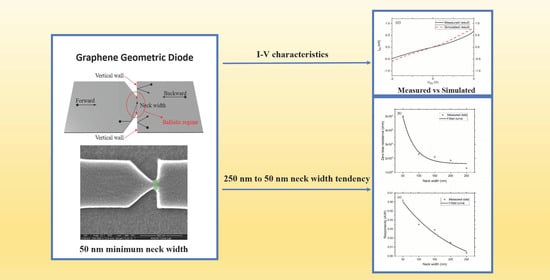CVD-Grown Monolayer Graphene-Based Geometric Diode for THz Rectennas
Abstract
:1. Introduction
2. Materials and Methods
2.1. Concept and Working Principle
2.2. Fabrication
3. Results and Discussion
3.1. Electrical Characterization
3.2. Verification through Monte Carlo Simulation
4. Conclusions
Author Contributions
Funding
Data Availability Statement
Conflicts of Interest
References
- Wang, R.-C.; Lin, Y.-C.; Chen, H.-C.; Lin, W.-Y. Energy harvesting from g-C3N4 piezoelectric nanogenerators. Nano Energy 2021, 83, 105743. [Google Scholar] [CrossRef]
- Nandakumar, D.K.; Vaghasiya, J.; Yang, L.; Zhang, Y.; Tan, S.C. A solar cell that breathes in moisture for energy generation. Nano Energy 2020, 68, 104263. [Google Scholar] [CrossRef]
- Cuong, T.T.; Le, H.A.; Khai, N.M.; Hung, P.A.; Linh, L.T.; Thanh, N.V.; Tri, N.D.; Huan, N.X. Renewable energy from biomass surplus resource: Potential of power generation from rice straw in Vietnam. Sci. Rep. 2021, 11, 792. [Google Scholar] [CrossRef] [PubMed]
- Gadalla, M.; Abdel-Rahman, M.; Shamim, A. Design, Optimization and Fabrication of a 28.3 THz Nano-Rectenna for Infrared Detection and Rectification. Sci. Rep. 2014, 4, 4270. [Google Scholar] [CrossRef]
- Donchev, E.; Pang, J.S.; Gammon, P.M.; Centeno, A.; Xie, F.; Petrov, P.K.; Breeze, J.; Ryan, M.P.; Riley, D.J.; McN, N. The rectenna device: From theory to practice (a review). MRS Energy Sustain. 2014, 1, E1. [Google Scholar] [CrossRef] [Green Version]
- Shanawani, M.; Masotti, D.; Costanzo, A. THz Rectennas and Their Design Rules. Electronics 2017, 6, 99. [Google Scholar] [CrossRef] [Green Version]
- Thacker, Z.; Pinhero, P.J. Terahertz Spectroscopy of Candidate Oxides in MIM Diodes for Terahertz Detection. IEEE Trans. Terahertz Sci. Technol. 2016, 6, 414–419. [Google Scholar] [CrossRef]
- Jayaswal, G.; Belkadi, A.; Meredov, A.; Pelz, B.; Moddel, G.; Shamim, A. Optical rectification through an Al2O3 based MIM passive rectenna at 28.3 THz. Mater. Today Energy 2018, 7, 1–9. [Google Scholar] [CrossRef]
- Zhu, Z.; Joshi, S.; Grover, S.; Moddel, G. Graphene geometric diodes for terahertz rectennas. J. Phys. D Appl. Phys. 2013, 46, 185101. [Google Scholar] [CrossRef]
- Zhu, Z.J. Graphene Geometric Diodes for Optical Rectennas. Master’s Thesis, University of Colorado at Boulder, Boulder, CO, USA, 2014. [Google Scholar]
- Backes, C.; Abdelkader, A.M.; Alonso, C.; Andrieux-Ledier, A.; Arenal, R.; Azpeitia, J.; Balakrishnan, N.; Banszerus, L.; Barjon, J.; Bartali, R.; et al. Production and processing of graphene and related materials. 2D Mater. 2020, 7, 022001. [Google Scholar] [CrossRef]
- Calado, V.E.; Zhu, S.-E.; Goswami, S.; Xu, Q.; Watanabe, K.; Taniguchi, T.; Janssen, G.C.A.M.; Vandersypen, L.M.K. Ballistic transport in graphene grown by chemical vapor deposition. Appl. Phys. Lett. 2014, 104, 023103. [Google Scholar] [CrossRef] [Green Version]
- Auton, G.; Zhang, J.; Kumar, R.K.; Wang, H.; Zhang, X.; Wang, Q.; Hill, E.; Song, A. Graphene ballistic nano-rectifier with very high responsivity. Nat. Commun. 2016, 7, 11670. [Google Scholar] [CrossRef] [PubMed]
- Takayanagi, K.; Kondo, Y.; Ohnishi, H. Suspended Gold Nanowires: Ballistic Transport of Electrons. JSAP Int. 2001, 3, 3–8. [Google Scholar]
- Blake, P.; Hill, E.; Neto, A.H.C.; Novoselov, K.; Jiang, D.; Yang, R.; Booth, T.; Geim, A.K. Making graphene visible. Appl. Phys. Lett. 2007, 91, 063124. [Google Scholar] [CrossRef] [Green Version]
- Deokar, G.; Avila, J.; Razado-Colambo, I.; Codron, J.-L.; Boyaval, C.; Galopin, E.; Asensio, M.-C.; Vignaud, D. Towards high quality CVD graphene growth and transfer. Carbon 2015, 89, 82–92. [Google Scholar] [CrossRef]
- Hakami, M.; Deokar, G.; Smajic, J.; Batra, N.; Costa, P.M.F.J. Can a procedure for the growth of single-layer graphene on copper be used in different chemical vapor deposition reactors? Chem. Asian J. 2021, 16, 1466–1474. [Google Scholar] [CrossRef]
- Wei, W.; Zhou, X.; Deokar, G.; Kim, H.; Belhaj, M.M.; Galopin, E.; Pallecchi, E.; Vignaud, D.; Happy, H. Graphene FETs With Aluminum Bottom-Gate Electrodes and Its Natural Oxide as Dielectrics. IEEE Trans. Electron Devices 2015, 62, 2769–2773. [Google Scholar] [CrossRef]
- Wang, Y.Y.; Ni, Z.; Yu, T.; Shen, Z.X.; Wang, H.; Wu, Y.H.; Chen, W.; Wee, A. Raman Studies of Monolayer Graphene: The Substrate Effect. J. Phys. Chem. C 2008, 112, 10637–10640. [Google Scholar] [CrossRef]
- Grover, S.; Moddel, G. Engineering the current–voltage characteristics of metal–insulator–metal diodes using double-insulator tunnel barriers. Solid State Electron. 2012, 67, 94–99. [Google Scholar] [CrossRef]
- Banszerus, L.; Schmitz, M.; Engels, S.; Goldsche, M.; Watanabe, K.; Taniguchi, T.; Beschoten, B.; Stampfer, C. Ballistic Transport Exceeding 28 μm in CVD Grown Graphene. Nano Lett. 2016, 16, 1387–1391. [Google Scholar] [CrossRef] [Green Version]
- Custer, J.P.; Low, J.D.; Hill, D.J.; Teitsworth, T.S.; Christesen, J.D.; McKinney, C.J.; McBride, J.R.; Brooke, M.A.; Warren, S.C.; Cahoon, J.F. Ratcheting quasi-ballistic electrons in silicon geometric diodes at room temperature. Science 2020, 368, 177–180. [Google Scholar] [CrossRef]
- Jouault, B.; Desrat, W.; Couturaud, O.; Contreras, S.; Mailly, D.; Mosser, V.; Zawadzki, W. Ballistic effects up to room temperature in microscopic Hall sensors. J. Appl. Phys. 2009, 105, 74504. [Google Scholar] [CrossRef]
- Cowley, A.M.; Sorensen, H.O. Quantitative Comparison of Solid-State Microwave Detectors. IEEE Trans. Microw. Theory Tech. 1966, 14, 588–602. [Google Scholar] [CrossRef]
- Stearns, J.; Moddel, G. Simulation of Z-Shaped Graphene Geometric Diodes Using Particle-In-Cell Monte Carlo Method in the Quasi-Ballistic Regime. Nanomaterials 2021. Submitted. [Google Scholar]
- Dorgan, V.E.; Bae, M.-H.; Pop, E. Mobility and saturation velocity in graphene on SiO2. Appl. Phys. Lett. 2010, 97, 082112. [Google Scholar] [CrossRef]
- Novoselov, K.; Geim, A.K.; Morozov, S.; Jiang, D.; Katsnelson, M.I.; Grigorieva, I.V.; Dubonos, S.V.; Firsov, A.A. Two-dimensional gas of massless Dirac fermions in graphene. Nat. Cell Biol. 2005, 438, 197–200. [Google Scholar] [CrossRef]
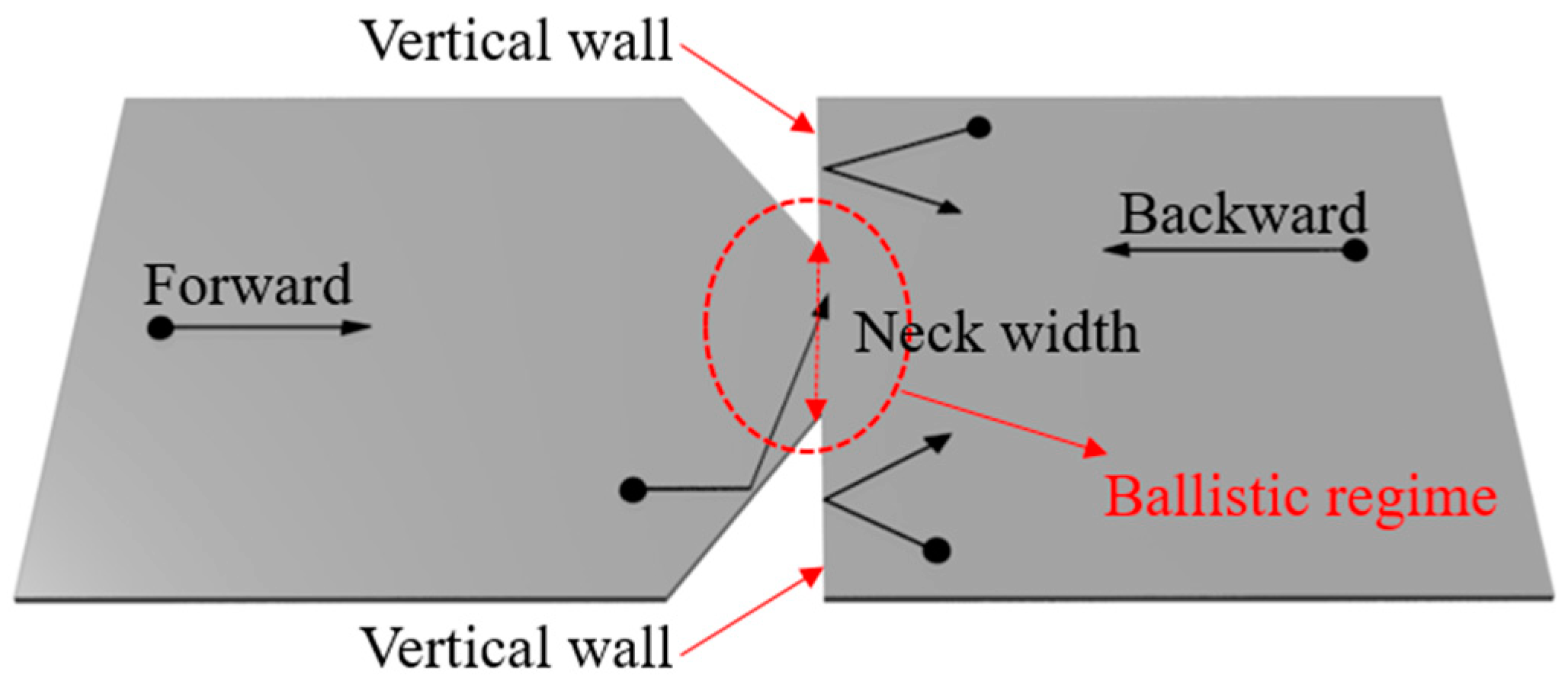
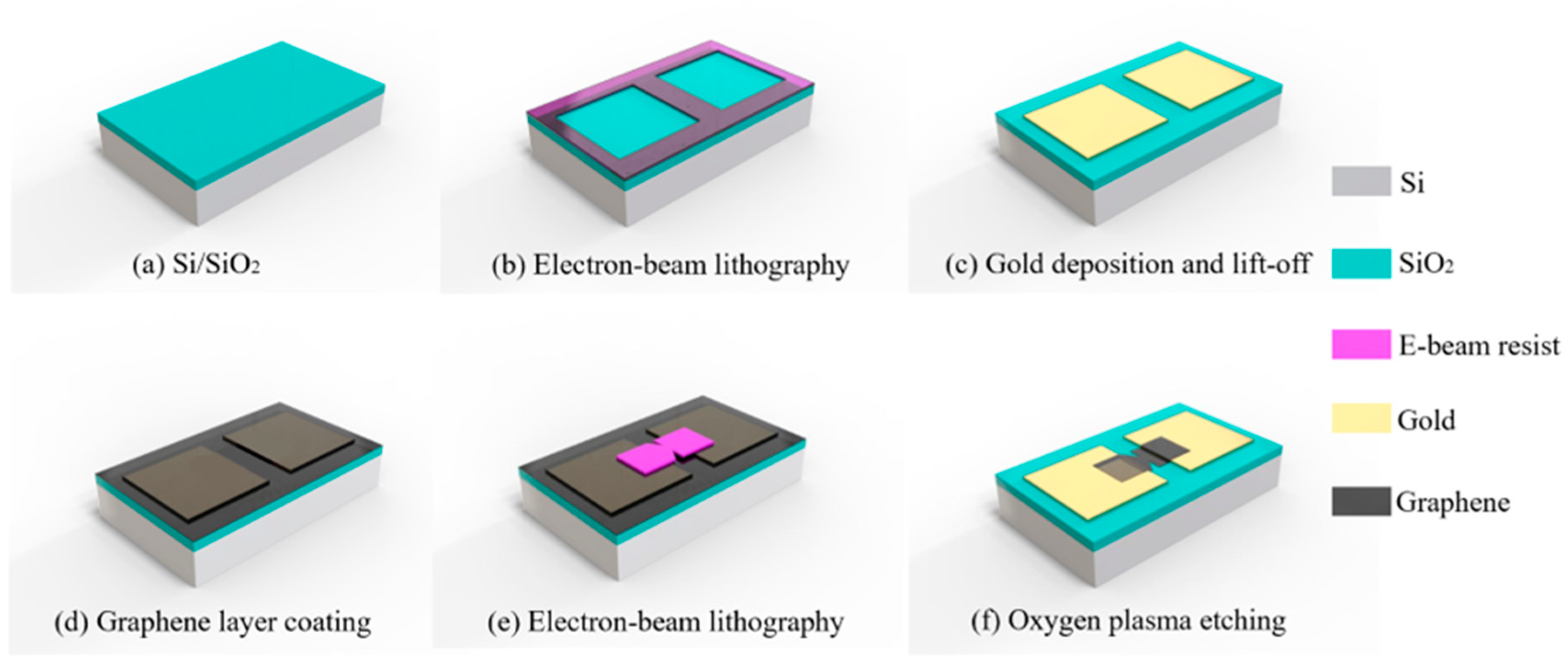
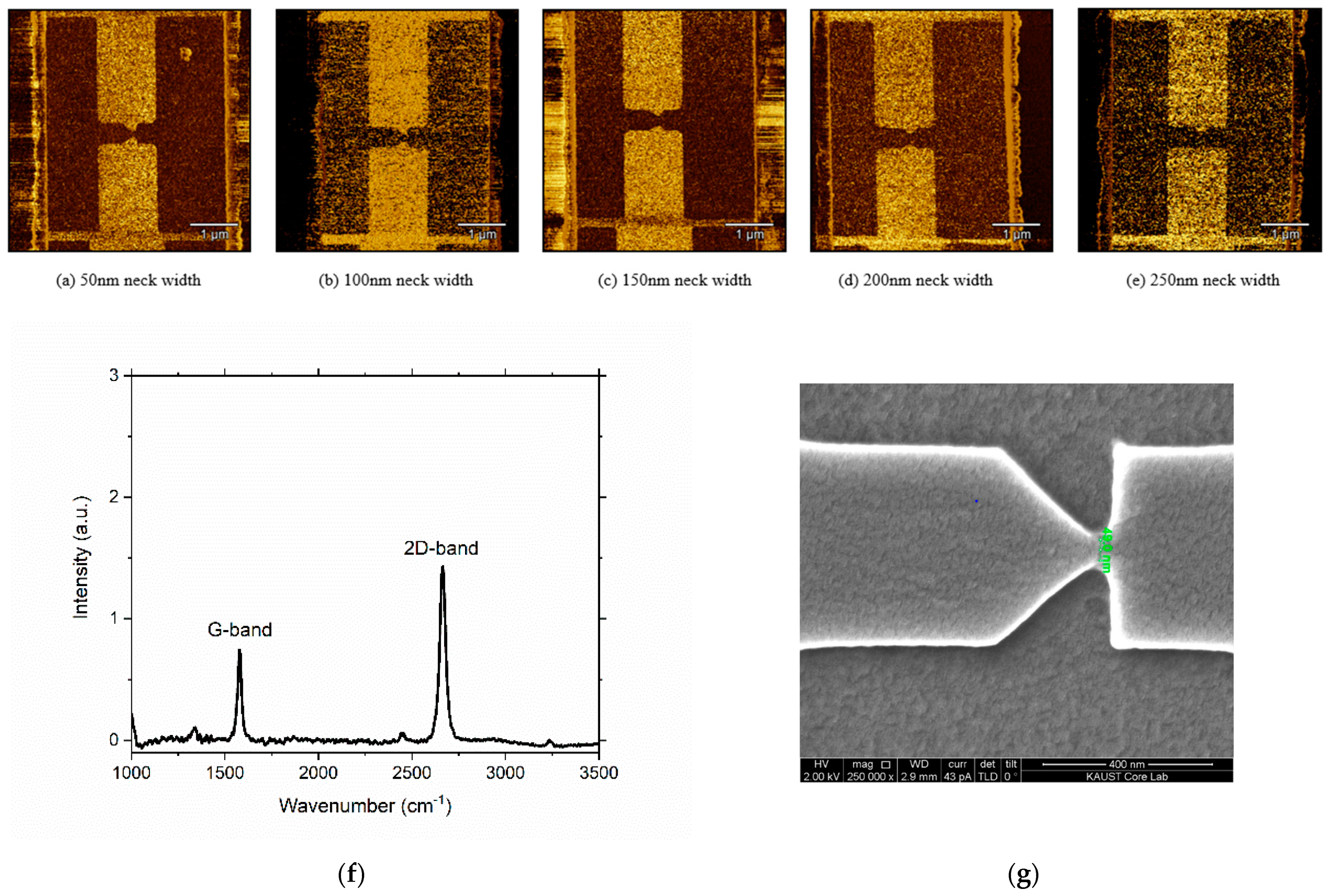
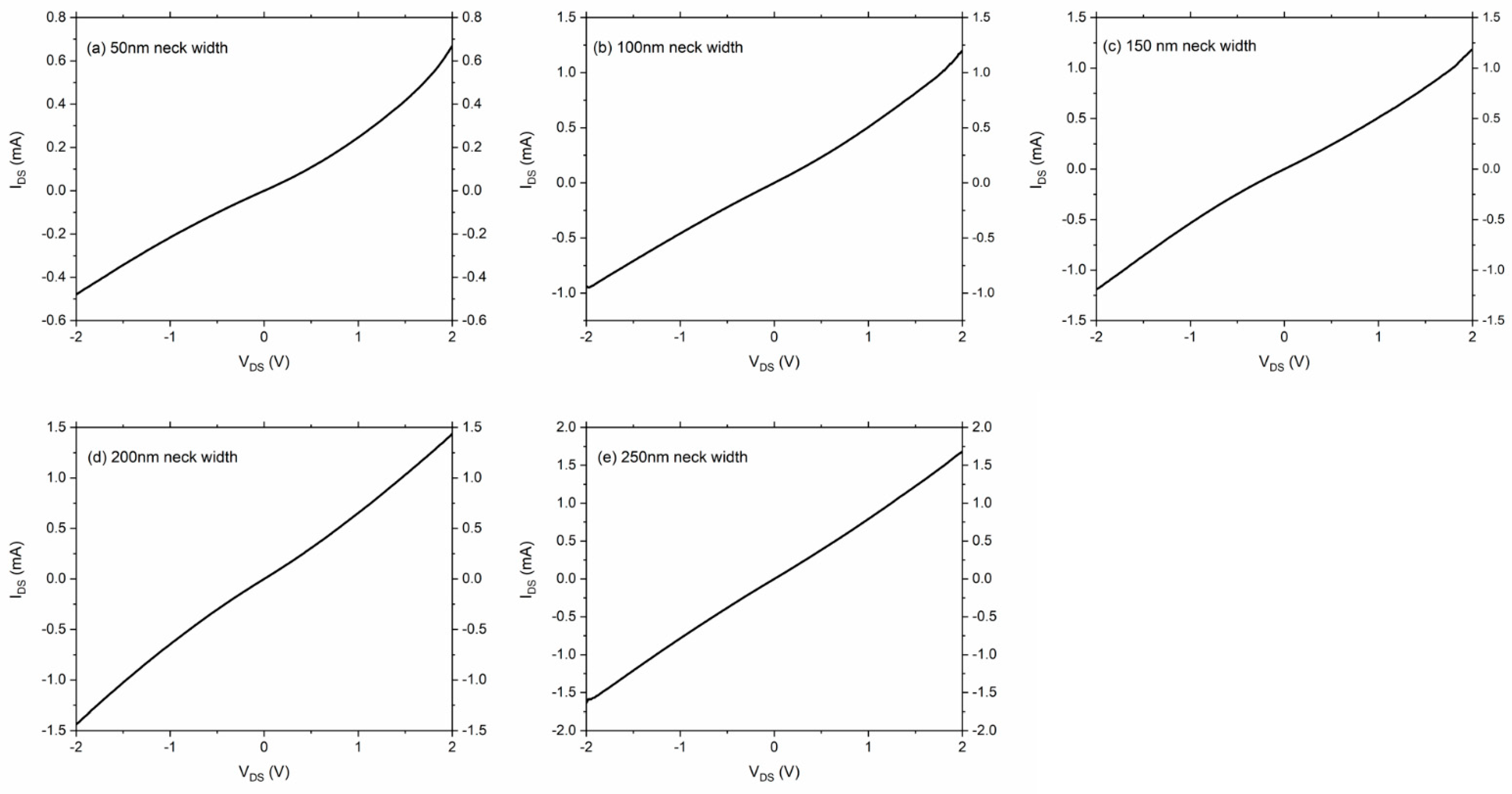
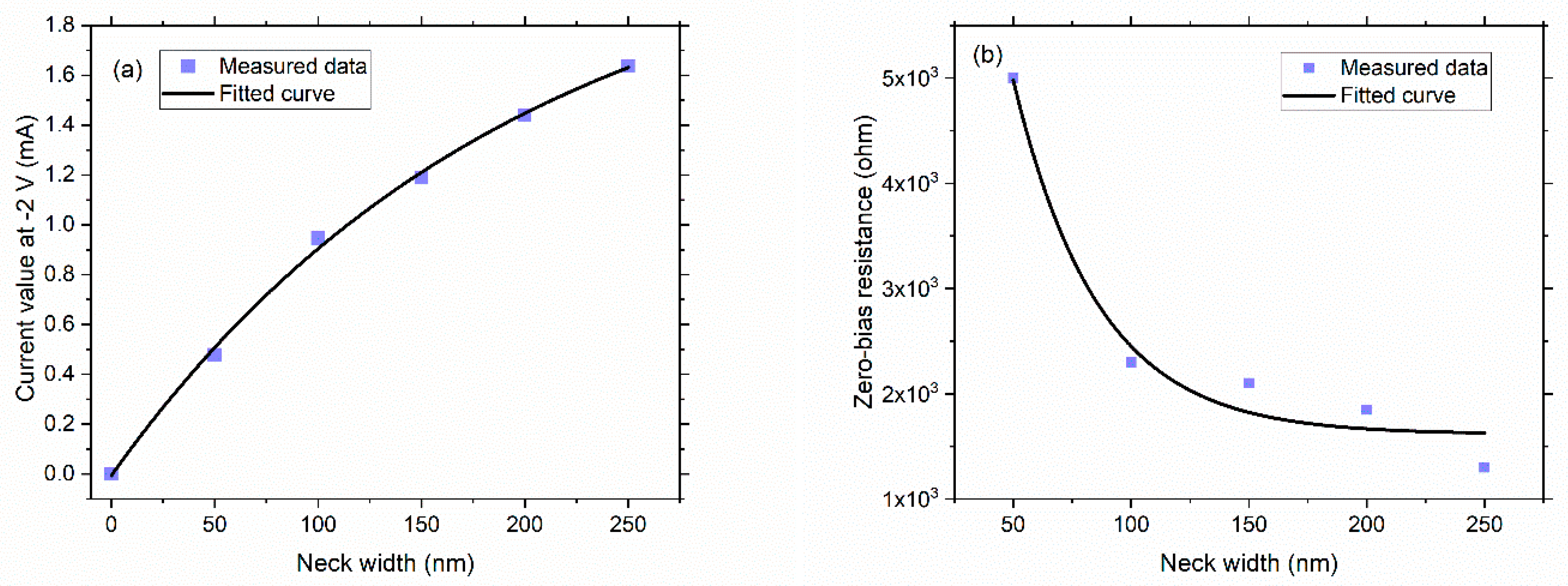
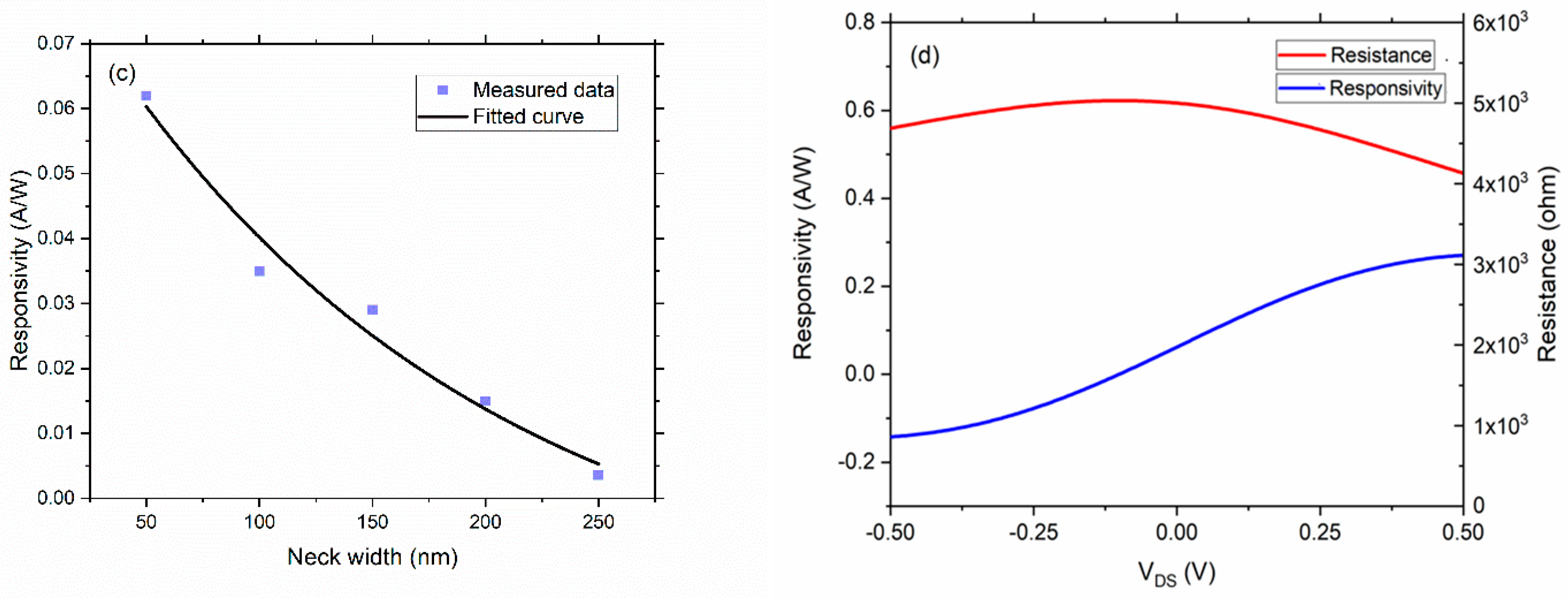

Publisher’s Note: MDPI stays neutral with regard to jurisdictional claims in published maps and institutional affiliations. |
© 2021 by the authors. Licensee MDPI, Basel, Switzerland. This article is an open access article distributed under the terms and conditions of the Creative Commons Attribution (CC BY) license (https://creativecommons.org/licenses/by/4.0/).
Share and Cite
Wang, H.; Jayaswal, G.; Deokar, G.; Stearns, J.; Costa, P.M.F.J.; Moddel, G.; Shamim, A. CVD-Grown Monolayer Graphene-Based Geometric Diode for THz Rectennas. Nanomaterials 2021, 11, 1986. https://doi.org/10.3390/nano11081986
Wang H, Jayaswal G, Deokar G, Stearns J, Costa PMFJ, Moddel G, Shamim A. CVD-Grown Monolayer Graphene-Based Geometric Diode for THz Rectennas. Nanomaterials. 2021; 11(8):1986. https://doi.org/10.3390/nano11081986
Chicago/Turabian StyleWang, Heng, Gaurav Jayaswal, Geetanjali Deokar, John Stearns, Pedro M. F. J. Costa, Garret Moddel, and Atif Shamim. 2021. "CVD-Grown Monolayer Graphene-Based Geometric Diode for THz Rectennas" Nanomaterials 11, no. 8: 1986. https://doi.org/10.3390/nano11081986
APA StyleWang, H., Jayaswal, G., Deokar, G., Stearns, J., Costa, P. M. F. J., Moddel, G., & Shamim, A. (2021). CVD-Grown Monolayer Graphene-Based Geometric Diode for THz Rectennas. Nanomaterials, 11(8), 1986. https://doi.org/10.3390/nano11081986





